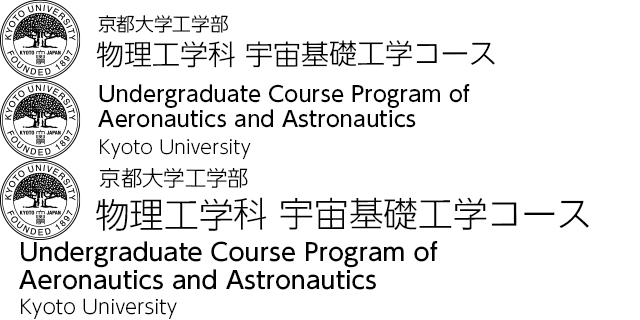Curriculum
In aerospace engineering, we have to overcome extreme engineering challenges under unknown or severe environmental conditions and thus have to develop innovative technology. This requires researchers and engineers with solid fundamental scholarship and the good ability to mobilize and apply it.
In view of the above, the Aeronautics and astronautics Course places emphasis on education in fundamental subjects, instead of imparting a large volume of technical knowledge, so that students can thoroughly acquire the fundamental principles of physics, mathematics, various branches of dynamics, etc. through many hours of study, thereby cultivating their intellectual competence to the fullest.
- Mathematics -
Students study Calculus A and B, Applied Calculus A and B, and Linear Algebra A and B, which are common to the School of Engineering Science Courses and required to pursue all the other subjects in the Aeronautics and Astronautics Course. On this foundation, students study Mathematical Statistics, Fundamental of Probability Theory, Applied Mathematics A1 (theory of functions of a complex variable), Applied Mathematics A2 (ordinary differential equation), and Applied Mathematics A3 (Fourier analysis), through which the basics of applied mathematics required in aerospace engineering are learned. Natural Phenomena and Mathematics is also offered as a bridge between fundamental mathematical subjects and more specialized subjects.
- Dynamics -
On the foundation of Basic Theories of Physics A and B taught in the first year, students learn modelling and analysis of phenomena of vibration in Vibration Engineering, and behaviour and control of dynamical systems related to aerospace vehicles in Flight Dynamics of Aerospace Vehicle, through which the basics and application of classical mechanics are learned. Control theories partially included in the Flight Dynamics of Aerospace Vehicle are further studied in Control Engineering 1, in which the basics of control theory, that is, the analysis and design by control theory for linear continuous systems, are studied.
- Physics -
On the foundation of Basic Theories of Physics A and B taught in the first year, students learn the basics of thermodynamics and statistical dynamics, indispensable in dealing with the motion of fluids and plasmas, in Statistical Physics and Statistical Thermodynamics; generation and transmission of electromagnetic waves in Applied Electromagnetism; the basics and description methodology of quantum mechanics in Quantum Physics 1; and theoretical and approximation methods of quantum mechanics in Quantum Physics 2. The basic knowledge and methodology of thermodynamics, statistical dynamics, electromagnetism and quantum mechanics learned through those subjects constitute the foundation for Plasma Physics and Fundamentals of Aerospace Propulsion; the former focuses on the basic equation of plasma and wave and transport phenomena in plasma, and the latter focuses on the basic matters of weakly ionized plasma and electric propulsion.
- Fluid dynamics -
In addition to the above mentioned Plasma Physics and Fundamentals of Aerospace Propulsion, students study subjects related to fluid dynamics, including Fluid Dynamics 1 and 2, Gas Dynamics, and Aerodynamics. In Fluid Dynamics 1, the basics common to various fields of fluid dynamics are learned. In Fluid Dynamics 2, students study the connection between macroscopic and microscopic fluid dynamics, with reference to the molecular gas dynamics or kinetic theory. In Gas Dynamics and Aerodynamics, students learn the basics and application of compressible fluid dynamics related to high-speed gas flows.
- Mechanics of Solids -
Students learn the basics and application of material deformation and stress in Mechanics of Materials 2 and the basics of elasticity, waves in solids and non-linear phenomena in Mechanics of Solids, through which the basics of statics and dynamics of solid materials are learned.
- Experiments and practical training -
In Engineering Laboratory in Aeronautics and Astronautics 1 and 2, students conduct experiments related to ionized gases, mechanics of solids, control engineering, fluid dynamics, and molecular gas dynamics. The focus of these experiments is placed, not on the acquisition of experimental techniques, but on the direct observation of and reflection on basic phenomena. In Exercise on Engineering Science 1 and 2, corporate engineers working in the front line of aerospace engineering are invited as lecturers and provide instruction in fundamental subjects required for aerospace apparatus design. Engineering Exercise in Aeronautics and Astronautics, conducted for special research projects, combines practical training with lectures on themes relevant to preliminary knowledge necessary for Graduate Research Work and related topics. This is a subject unique to our Aeronautics and Astronautics Course.
- Others -
In addition to the above mentioned subjects, students can learn the Electric Circuits and Differential Equations and Electric and Electronic Circuits. Ethical issues, which are growing increasingly important year by year, are dealt with in Engineering Ethics.
* Please note that the titles of subjects may differ from one academic year to another.
